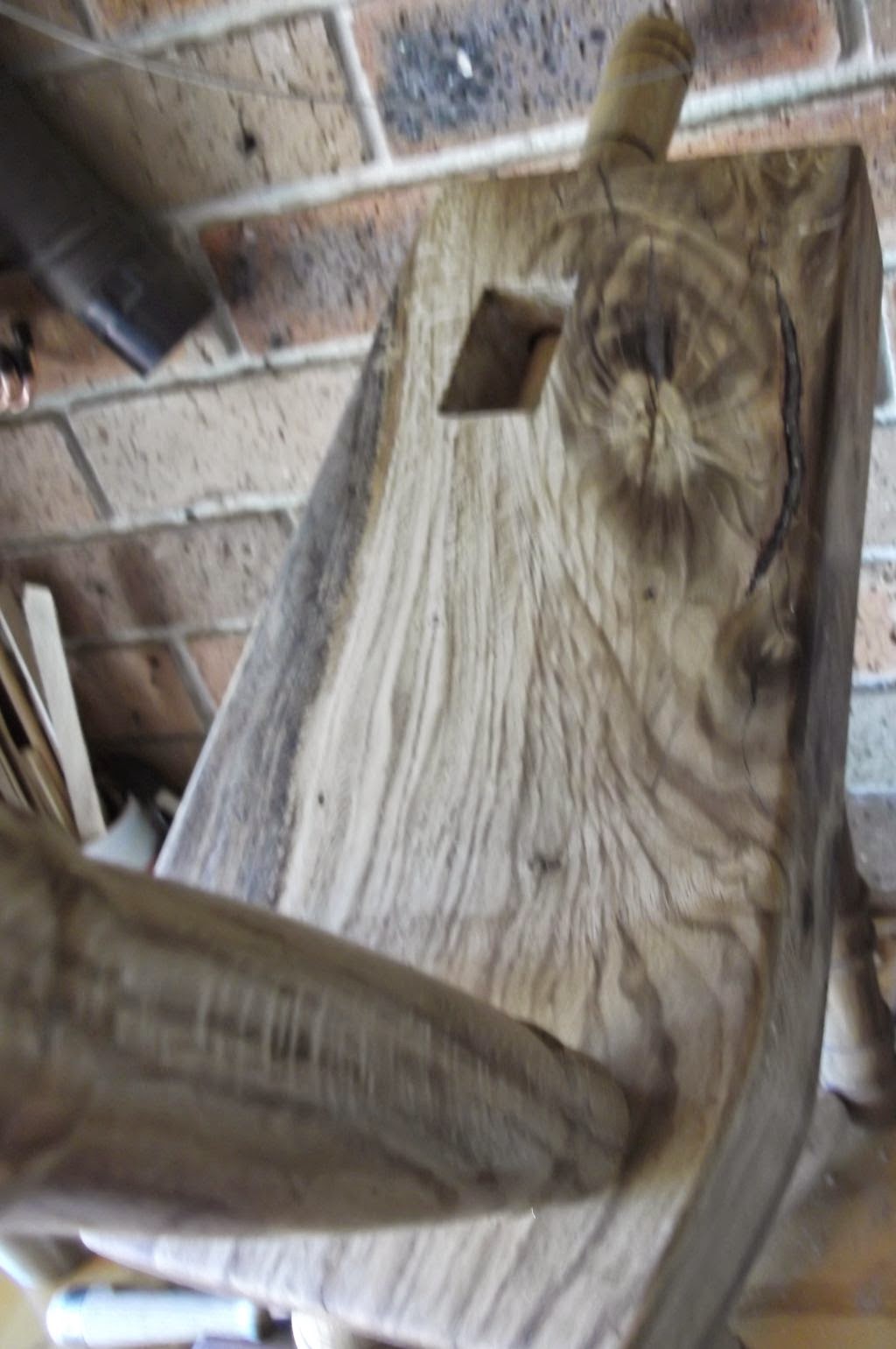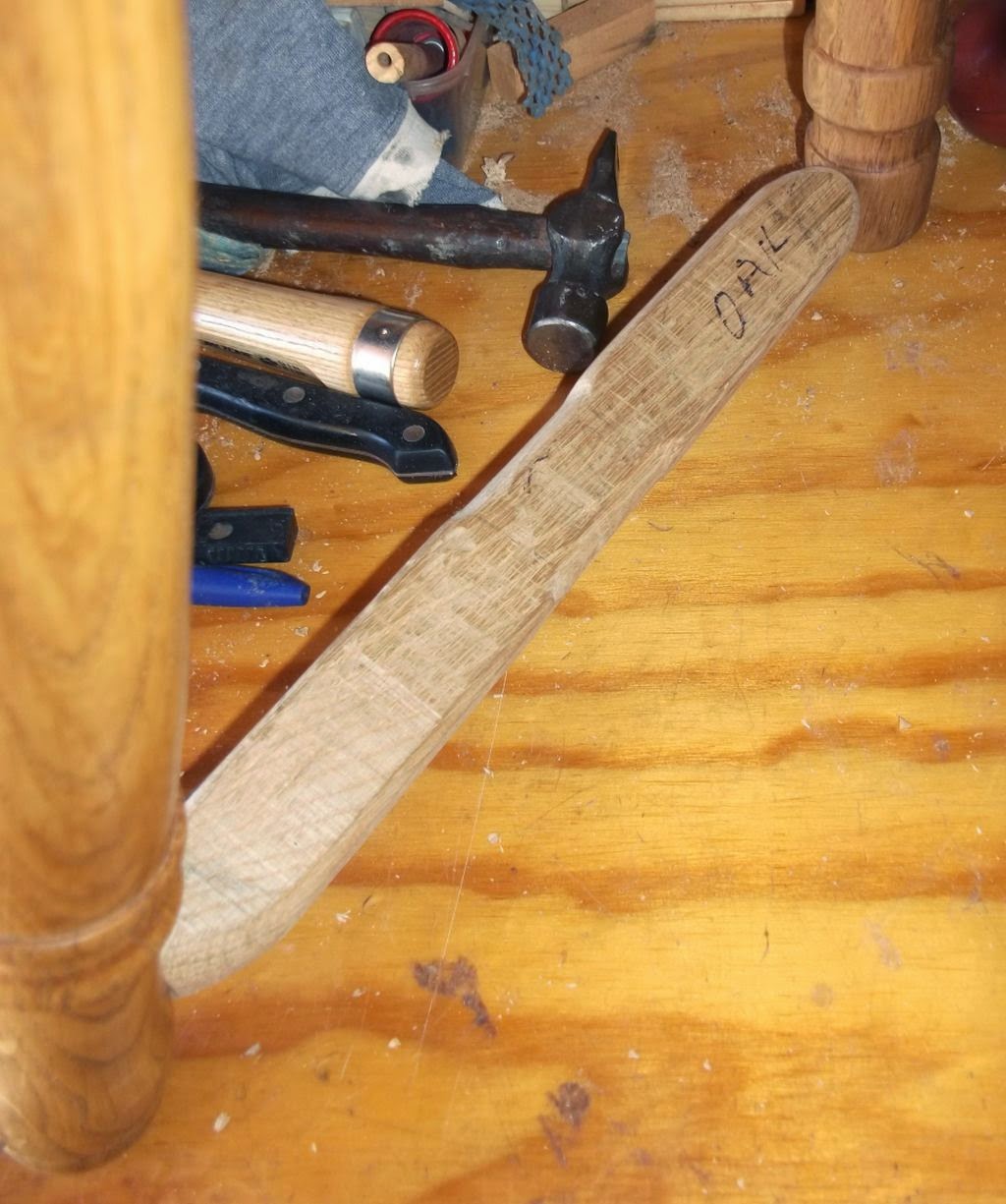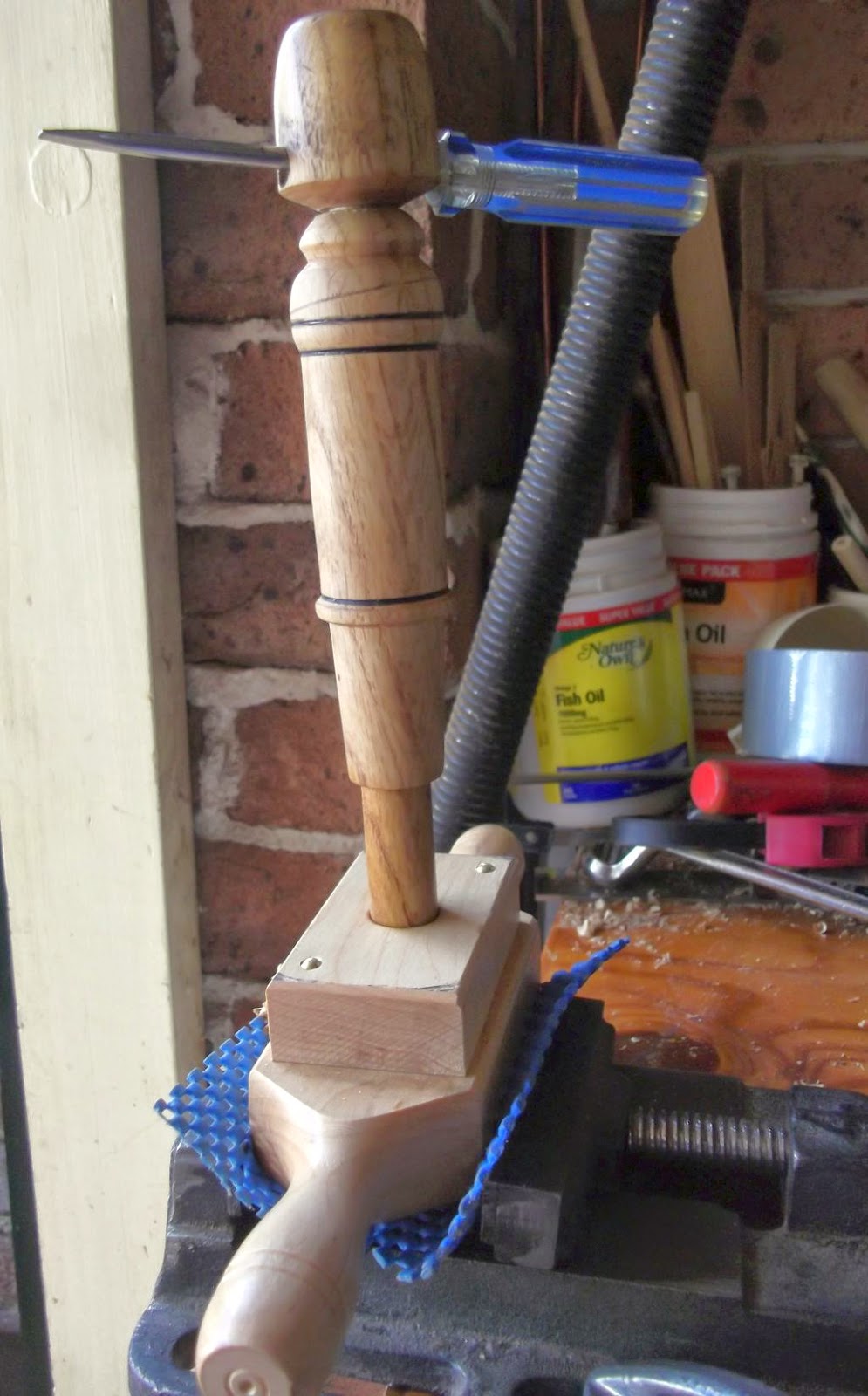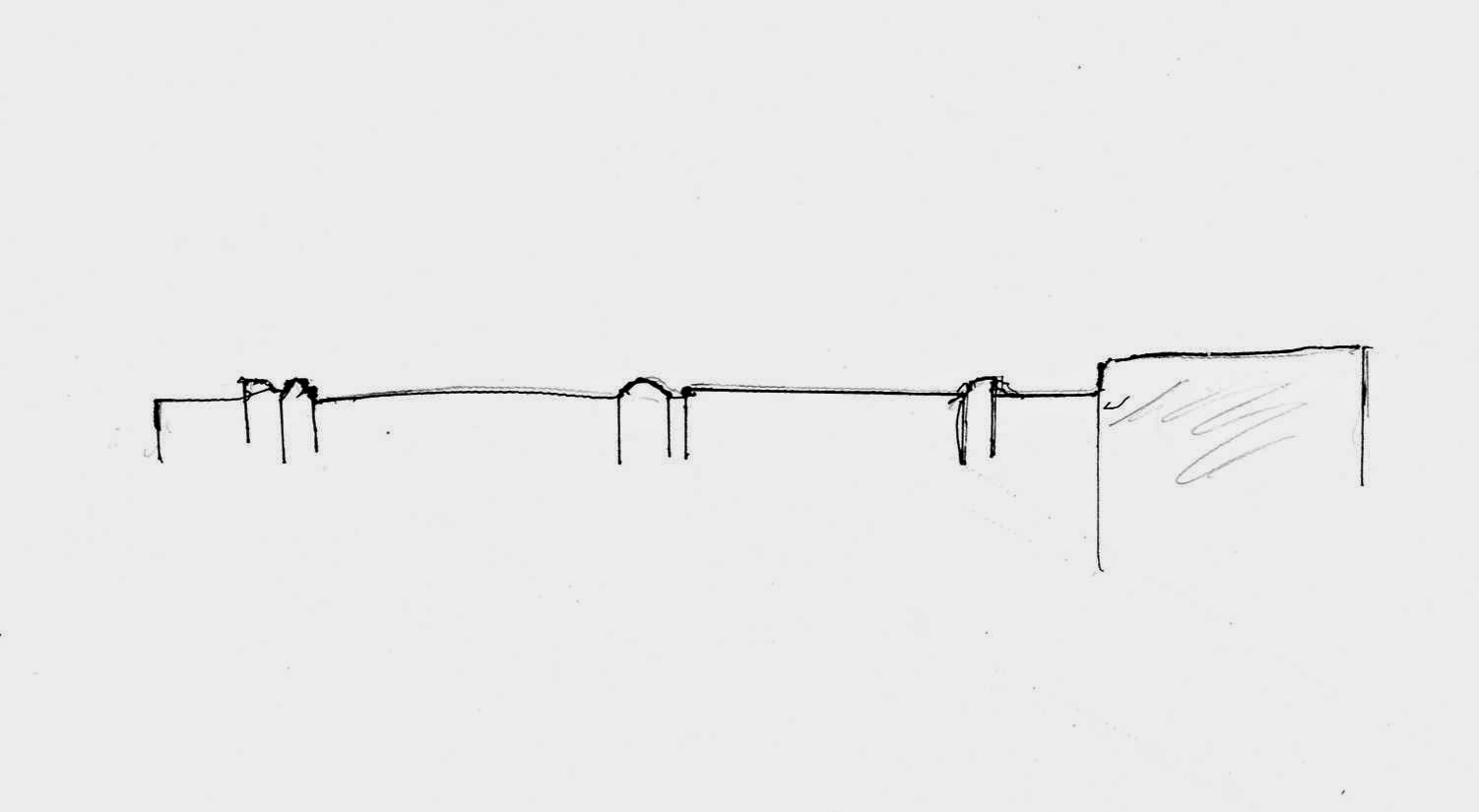 |
| Queen Victoria |
One upon a time, Long long ago.........a man built a wheel 200 years latter I had to repair and restore that wheel.
It all began back in
February 26th 2010. I knew what I was in for the moment I laid eyes on it.
"Can you make me one"?.
Being the person I am how could I say NO!!!!
Ok so five years latter.........can't rush these things can we.
As I restored what became known as Isla I made parts to replace the
damaged two castles, they where not required so they were for Orla as Sue has named her.
I
copied and created and redesigned as the need became apparent from the restoration transposing to the new over the years.
The bases of a wheel is as shown
here.
In making spare
Bobbins for
Isla I made six new ones for Ola.
Try as I may even stepping away fro the Ornamental Turners to get this finished still I found the word NO when asked to do other projects hard to say.
 |
| Ready to start again |
Still with much to do after Isla had been handed over, I was able to set about and continue the work.
I had yet to make the Footman, Connecting Rod, The wheel itself, The Flyer, make adjustments to parts long ago made. I had decided rather than to risk shrinkage and ill fitting to leave some timber to turn, sand or machine away and yet with weather things still changed.
The the Whorl/s (two were made various sizes to suit Sue spinning style) had to be refined to size and drilled. These need to be a tight fit to the shaft as its this connected by drive band to the wheel that makes the flyer spin.
The Flyer axle shaft had to be re-machined removing 10mm from the feed end to allow the whorl, bobbin and flyer arm to move over that distance to align better with the wheel and to not come into contact with the castle like Isla's had.
The Flyer and axle shaft fitted together as a push fit, twelve holes drilled to fit the required hooks. These were off set to each other either side as Sue requested, it allows for a more even feed across the bobbin rather than a hills and valley arrangement.
A second flyer is to be made which will allow larger bobbins this means I'll have to make a second shaft the first was made by Greg Gossip as was the main wheel shaft which was then forged to shape by a Blacksmith from the Blue mountains Wyndham is his name.
The main Hub had to be drilled and shaped by file to take the square section of the shaft.
The longest leg when originally made was a concern as it had an amount of Oak Burl area which was at the top end it broke during a removal it had shown signs of weakness. Darrell Smith from OTGA was able to supply me with a better piece and I had it turned and fitted the next day.
To look at the whole wheel one would say a number of Oak trees supplied the wood but majority was all cut from the same log. Alan Flett supplied me with a board of Oak as I had to remake the fellows of the wheel thicker than they had been dressed to 22mm and were very spalted. I couldn't risk warping or weak wall thickness after drilling holes for the spokes.
The two wheel uprights had to have the axle slots cut as well as removal of material and length adjustments made.
Sue had asked for the Footman not be as Isla's was but to have the joint hidden. So I used Mortise and Tenon joints to connect to the rocker shaft joint. While I just removed enough material forming mortise on both where both parts crossed over not quite making them level on purpose.
The adjustment knob and block had to be threaded also the hole in the main table had to be shaped to suit the taper of the knob.
Thanks goes to mark Alyward for the loan of his 3/4 x 6tpi Wood Threading Kit this save me for now making or buying my own and allowed me to complete the project sooner. I did a test cut of thread on an old broom handle it didn't go well as per the instructions and suggestion from Mark I soaked the oak handle in Neats Foot oil over night. It cut much better although some chipping of the thread occurred a little CA fixed that.
The same goes for Alan Flett who took the fellows I had cut to make the wheel, he used Domino's and Tongue and Groove to join them. He also cut the outside radius leaving me the inside to mark out for length of spokes, then for me to cut that and drill the spoke holes and glue and assemble.
The axle shaft had to be machined to size of the hub I had to remove square section each side by approx 8mm. Again this is just a push fit with a drop of CA each end to secure.
I had to add a base section to the maiden support this was to give a better height supporting the centre pin as well as coverage of the slot which the maiden slides back o when adjusted. The material I had to make the block was not high/thick enough.
 |
| A new main leg after the first cracked where burl was. |
 |
| adding height to the Maiden support. |
 |
| The unfinished grain |
 |
| The large knot adding to the character |
 |
| My makeshift scraper Alan's old plain blade |

 |
| Footman |

 |
| Drilling out Mortice for footman |


Cutting threads for the adjuster.
 |
| Original design for spokes |



Above left, fitting the Maiden.
Above right the flyer assembled and drilled.
Left flyer mounted.
Right hub and spoke.
Below aligning spoke to rim to true the inner dia and mark spoke position.
Above the bottom of the main wheel castles sitting below the bed. Right soaking in oil so they can have a thread cut. Oak lock nuts turned and threaded fitted to castles below. This stops movement and allows tension over time.
The wheel was set up to true after assembly, after going along so well
Murphys Law dropped in for a visit.
In
mounting the assembled wheel onto the lathe to true the outer rim and
cut the groove for the drive band, everything was going well then all of
a sudden the whole thing went out of round and set a wobble in as well.
No matter what I tried where I placed the chuck it just wanted to do
its own thing.

Above the first wheel felloes being faced, truing centre aligning spokes to rim and marking out. Left the truing up using Cole Jaws assembled wheel.
This is where it all went wrong, I believe the force of cutting tool even though light had moved spokes in opposing directions. It should not have being the Cole Jaws were used.
That wheel became scrap and I proceeded to make new spokes and hub. Mean while Alan had on the same day tried to fight with a router and lost part of his finger. Alan was incremental in making the felloes for me. So with months of healing time and a few other things like Christmas, Birthdays, summer heat we both took to doing what we could on other works. Alan dropped off the new felloes still English Oak but what a contrast in colour grain and even between sides, still there is not much I could do timber is timber.
These were mortised and tenon or some would say tongue and grove jointed, much stronger and longer tongue than previous felloes and a little wider.
The new hub was not as good as the original so I scavenged that one and went to work making all fit. Alan had also made up Rivin Pins (dowels), these were to secure the felloes together. No glue has been used to allow for movement as in years gone by seeing what movement has taken place on two of Sue's other wheels that were glued it will make repair easier if ever it needs to be.
The Mother Of Awl required some fine tuning and whorls drilled to suit the shaft with a tight push on fit. A lock peg made and a connecting rod between footman and crank. The flyer shaft some machining and a pin fitted to lock all together.
Once all assembled and a test run proved successful it become apparent the wheel was almost done just minor adjustments and of course a full test to do.
I dare say Sue will ask for some changes or further adjustments as time goes by I will gladly do them and I hope in years to come someone will look back into its history.
A new style spoke and hub below the spokes were resize to length once the new felloes were trued.
This time using the cole jaws and the riven pins it was much easier and it proved the best way not having hub and axle and spokes fitted.
 |
| New spokes. |
Dry fit of the rim, holes drilled for Rivin Pins.
Clamping to bring it all together.
Above Rivin Pins helped realign and tighten it all after fitting they were trimmed. Note the colour and grain on this side compared to the side below.
Oiled and mounted.
Again the colour variation.
Above and below all assembled for test run
Minor work to do includes trim the wheel castles by 1/2", leather shaft carries cut for the Maiden flyer. Drive Band fitted, connecting rod fitted,
Final photos and video of it in full working order will be added over the coming weeks.
Thanks goes to the following:-
To all who have followed patiently this build many thanks
Darrell Smith and Tom Cattell from OTGA who supplied me with all the English Oak except for the felloes. Darrelle also cut and dressed it to rough sizes.
Wyndham the Blue Mnts Blacksmith for forging the crank.
Greg Gossip for machining the main axle and the flyer shaft.
Alan Flett who supplied the original master copy and English Oak for the Felloes as well as dressed and produced the joints.
Sue who patiently waited the years while other projects jumped queue, supported me in many ways more than she knows throughout the build. Her constant help when I needed it. The many photos taken I hope she gets years of pleasure out of it.
Conclusion:-
My fault I never documented time when build this wheel a big mistake on my part.
Would I build another? YES!
This time no interruptions.
Would I use English oak again? Yes! OR Rosewood or maybe even Huon Pine.




























































